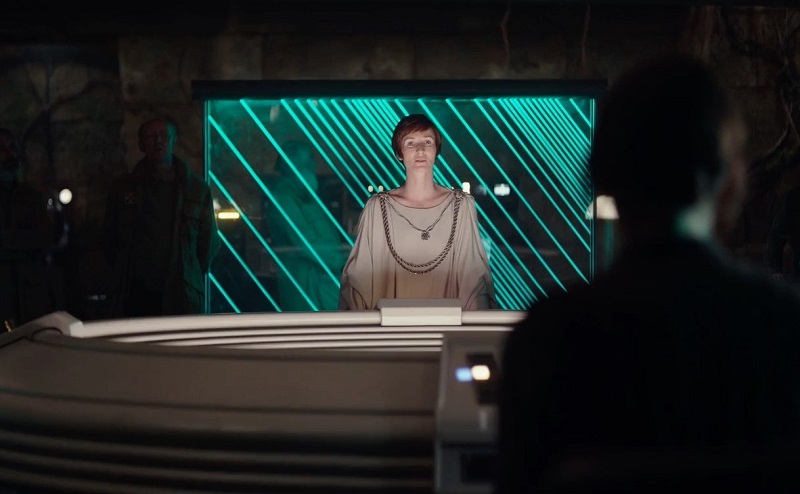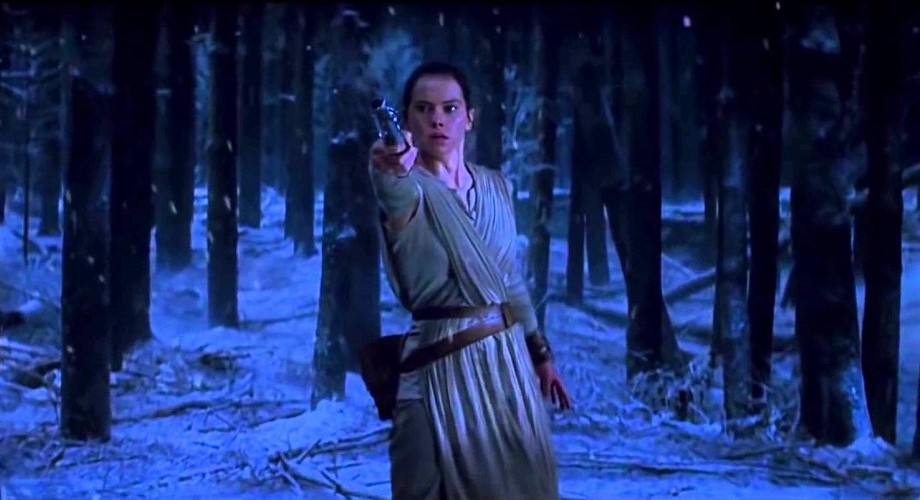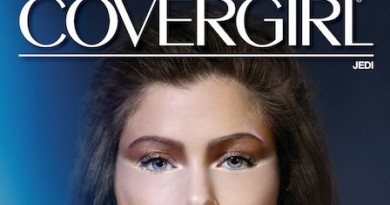From Mon Mothma to Jyn Erso: Celebrating the Women of Star Wars
 by Kristin Baver
by Kristin Baver
Impulsive Jyn Erso may just be the scoundrel we’ve been looking for, striding onto the rebel base and into theaters via Rogue One: A Star Wars Story. But there’s no doubt even-keeled Mon Mothma will be there to help guide her and the rest of the rebels aiming to take down the Empire with a daring heist of the Death Star plans.
With just a few days to go before the premiere, fans are about to have months of speculation and burning questions answered at long last. From what we’ve gleaned so far, through cast interviews, canon-approved backstories, and the blurbs on our action figure boxes, Jyn is an impetuous and defiant young woman who’s reluctant to join the rebel cause. In a recent interview with Glamour, the actor behind the cowl, Felicity Jones, called the character “a rather beautiful blend of Luke Skywalker and Han Solo.” That suggests Jyn is equal parts young idealist and sassy pirate, a perfect mix of hope and heroics. But don’t expect a rehash of the original male leads melded together and gender swapped for the next generation. Jones also promised that Jyn is her own woman and from what we know so far, she’s a fiercely intelligent, flawed human who is neither sexualized nor objectified in her role among the diverse ranks of the rebel warriors.
 Part of what makes Jyn such a promising addition to the women of the Star Wars canon is the refreshing departure from over sexualization that so often plagues feminine heros across the fantasy and sci-fi genres. Take the design of her costume just as one example that’s easily accessible from teasers and trailers. The franchise that dressed its original heroine in that infamous gold bikini three decades ago has clothed its new leading lady in garb befitting a fighter. (And we’re not talking skin-tight catsuit.) Jyn looks as if she were ready to go into combat in a dusty, arid land, her trusty blaster at her side. Although Disney and Lucasfilm have kept the details of Jyn’s story under wraps — Why is she in handcuffs? Who did she assault? What’s happening?! — you can already get a look at her early years. The James Luceno-penned Catalyst: A Rogue One Novel digs into the origins of the Empire’s ultimate weapon while simultaneously fleshing out the relationship between Jyn’s parents, Galen and Lyra, perhaps providing the most specific insight (so far) into the type of woman Jyn may yet grow up to be.
Part of what makes Jyn such a promising addition to the women of the Star Wars canon is the refreshing departure from over sexualization that so often plagues feminine heros across the fantasy and sci-fi genres. Take the design of her costume just as one example that’s easily accessible from teasers and trailers. The franchise that dressed its original heroine in that infamous gold bikini three decades ago has clothed its new leading lady in garb befitting a fighter. (And we’re not talking skin-tight catsuit.) Jyn looks as if she were ready to go into combat in a dusty, arid land, her trusty blaster at her side. Although Disney and Lucasfilm have kept the details of Jyn’s story under wraps — Why is she in handcuffs? Who did she assault? What’s happening?! — you can already get a look at her early years. The James Luceno-penned Catalyst: A Rogue One Novel digs into the origins of the Empire’s ultimate weapon while simultaneously fleshing out the relationship between Jyn’s parents, Galen and Lyra, perhaps providing the most specific insight (so far) into the type of woman Jyn may yet grow up to be.
In an interview with Entertainment Weekly, Lucasfilm president Kathleen Kennedy also promised that Rogue One would deliver more screen time for Mon Mothma, the ginger-haired former senator from Chandrila. Kennedy told fans to expect a “significantly larger” role for Mon than in her Return of the Jedi debut or her brief-but-ultimately-deleted appearance in Revenge of the Sith. In terms of visual continuity, casting actor Genevieve O’Reilly as the younger version of the original Mon played by Caroline Blakiston is pure genius. Who among us watched the first trailer and didn’t squeal with giddy delight as Mon Mothma filled the screen? Fans of The Clone Wars TV series have gotten considerably better acquainted with the rebel leader, but let’s focus our attention on our first sighting, as she delivered somber news of the Bothans’ sacrifice to deliver information on the location of the second Death Star. In that brief Jedi debriefing, Mon exudes the stateliness befitting the mother of the Rebellion, and we can easily imagine that same steady hand leading the rebels in their mission to secure the Death Star intelligence before the imminent weapons test. This also sets up Mon as the perfect foil for Jyn’s rough-and-tumble hero. The war-weary leader understands that sacrifices will have to be made for the greater good and an organized alliance is more powerful standing together than a smattering of rogue rebel cells fighting the Imperial elite. And those Bothans? They serve as a reminder that with a core team of characters who are almost completely new to the canon, we could be in for some serious bloodletting in the Rogue melees ahead. But we know Mon Mothma will survive to fight another day, and her dignified presence will help to steer the Rebellion to greatness and the eventual birth of the new Republic.
To better appreciate what these two characters can bring to the saga and how they further the goals of making a galaxy far, far away a more diversely populated realm, we need to take a look back at the women who have come before:
Princess Leia Organa – We already know that the Rogue rebels will ultimately succeed in their mission to obtain the Death Star plans, because we’ve already seen Leia stowing them safely in R2-D2, then jettisoning the escape pod carrying the petite astromech and his counterpart just as her ship, Tantive IV, was being boarded by Imperials.  Leia was the saga’s original female badass, but the recent additions of Rey and now Jyn point to an important shift in thinking about these characters within the franchise. Despite being a formidable triple threat — royal standing, senatorial duties, and work as a rebel operative — Leia’s story arc was arguably too often reduced to her feelings for Han Solo and the idea that someone needed to be protecting her at all times. Still, despite this hiccup, she always held her own whether blasting her way into a garbage chute, holding a thermal detonator to save Han’s skin once again, or commanding rebel fighters from countless war rooms. Off-screen, the extended canon in Marvel’s comics has made great strides to better articulate Leia’s dominance as a leader, her prowess as a pilot, and showcase an array of fierce hand-to-hand combat skills that sometimes included headbutting her foe.
Leia was the saga’s original female badass, but the recent additions of Rey and now Jyn point to an important shift in thinking about these characters within the franchise. Despite being a formidable triple threat — royal standing, senatorial duties, and work as a rebel operative — Leia’s story arc was arguably too often reduced to her feelings for Han Solo and the idea that someone needed to be protecting her at all times. Still, despite this hiccup, she always held her own whether blasting her way into a garbage chute, holding a thermal detonator to save Han’s skin once again, or commanding rebel fighters from countless war rooms. Off-screen, the extended canon in Marvel’s comics has made great strides to better articulate Leia’s dominance as a leader, her prowess as a pilot, and showcase an array of fierce hand-to-hand combat skills that sometimes included headbutting her foe.
Padmé Amidala – The woman who birthed Leia and Luke gets a bad rap for her part in the prequel trilogy. After being elected Queen of Naboo at the tender age of 14, and ultimately joining the senate after her reign, Padmé maintains her political career while simultaneously engaging in a clandestine marriage with Jedi Knight Anakin Skywalker. But regardless of your feelings for Episodes I-III, there are a number of things Padmé gets right as a character. You can’t argue that she is deeply flawed in a perfectly humanized way. Again, like her future daughter, Padmé’s story arc is too often reduced to her feelings for Anakin. Love story aside, Padmé should be celebrated as a political wunderkind who’s also pretty good in a fight. And when she ultimately dies after seemingly losing the will to live, it’s more than just her broken heart over Anakin’s turn to the dark side at play here. Padmé has just watched the democracy she believed in and fought for crumble, bending to the will of the gnarled and two-faced Chancellor Palpatine whose push for emergency powers would eventually create the Empire.  In this way, it’s easy to imagine her representing an entire galaxy of citizens too worn down to fight, a long-game manipulation of the will of the people that was necessary to set up the Imperial’s tyrannical rise to power.
In this way, it’s easy to imagine her representing an entire galaxy of citizens too worn down to fight, a long-game manipulation of the will of the people that was necessary to set up the Imperial’s tyrannical rise to power.
Ahsoka Tano — Anakin Skywalker’s Jedi apprentice is a fan favorite among viewers of The Clone Wars and now Star Wars Rebels, a headstrong young Togruta who is as impulsive and, like Jyn, impatient with the bureaucracy and rules that come along with her role. Although Ahsoka left the Jedi by her own choice before Order 66 annihilated most of the Force users, when we meet her among the rebel’s Phoenix squadron she is still a badass, dual-lightsaber wielding fighter who can flatten her adversaries with a wave of her hand. Other than possibly Darth Vader, given Rogue One‘s placement in the Star Wars timeline there’s little expectation of Force users and lightsaber duels in the new film.
Hera Syndulla — The captain of the Ghost crew is a skilled pilot who’s always ready for the next rescue mission. Remember Oola, Jabba’s original Twi’lek dancer and captive? Well, this Twi’lek is no one’s slave. Hera treats her crew like family, protecting them and helping to guide their emotional well-being with a maternal benevolence that often gives way to a disapproving frown when they disobey her direct orders. Although these additions to the canon only exist in animated form thus far, Hera and Ahsoka are just as three-dimensional as their on-screen counterparts and along with the likes of Sabine Wren and Steela Gerrera, they earn their place on this list by teaching a generation of younger fans that the gender stereotypes we’re still fighting in the 21st century have no place in the Star Wars universe.
Rey … — Saving one of the best for last, feminists can’t help but love Rey. She’s gritty and realistic in a way that felt completely fresh when The Force Awakens debuted and there are so many reasons to love her. She transcends the need for action stars to pull double duty as fash ion plates, wearing the perfect desert survivalist gear for a scavenger whose entire life is a patchwork of found objects and other people’s garbage. Rey gets sweaty and doesn’t oddly show up in a post-combat scene with flawless makeup still intact. Her hair is tied back because she needs it out of her face to fight for her life — another welcome change from heroines entering combat with long, flowing locks that perplexingly never become a liability. Leia didn’t need rescuing, and Rey certainly doesn’t need help either. “I know how to run without you holding my hand!” she bellows at Finn, who comes off as much more of the quintessential damsel in distress than Rey ever could. She can pilot and repair the Millenium Falcon. She expertly wields Luke’s lightsaber against a wannabe Sith after only just discovering that not only were the Jedi real, but, hey!, she’s Force-sensitive. The list goes on, but as the lead hero in the new trilogy, Rey heralds a new era of strong, complicated, fully-formed female characters that Jyn and Mon are sure to uphold.
ion plates, wearing the perfect desert survivalist gear for a scavenger whose entire life is a patchwork of found objects and other people’s garbage. Rey gets sweaty and doesn’t oddly show up in a post-combat scene with flawless makeup still intact. Her hair is tied back because she needs it out of her face to fight for her life — another welcome change from heroines entering combat with long, flowing locks that perplexingly never become a liability. Leia didn’t need rescuing, and Rey certainly doesn’t need help either. “I know how to run without you holding my hand!” she bellows at Finn, who comes off as much more of the quintessential damsel in distress than Rey ever could. She can pilot and repair the Millenium Falcon. She expertly wields Luke’s lightsaber against a wannabe Sith after only just discovering that not only were the Jedi real, but, hey!, she’s Force-sensitive. The list goes on, but as the lead hero in the new trilogy, Rey heralds a new era of strong, complicated, fully-formed female characters that Jyn and Mon are sure to uphold.
Kristin Baver is a feminist and lifelong sci-fi geek who puts her journalism skills to good use as a regular contributor at StarWars.com and other internet venues. This is her first piece for FANgirl Blog. Follow her @KristinBaver.
- Hyperspace Theories: One Year Later as ANDOR Kicks Off Season Two - May 15, 2025
- REVIEW: Tales of the Underworld - May 4, 2025
- Hyperspace Theories: From Star Wars Celebration Japan - May 3, 2025











Thankfully, the Expanded Universe was kicked to the curb, which erased one of the most obnoxious, overblown female character ever, who Leia was degraded and weakened and almost killed to glorify: Mara Jade. I hated her fictional guts, and she horned in on EVERYTHING. She was eventually whacked, and died a martyr, and was pushing 60 but looked 25 on the cover of the book. (Luke, on the back, was made to look his age, which was also 60.) Her death was treated as the greatest tragedy the galaxy had ever faced. I’m sure if they’d gotten as far as Leia’s death, it would have been treated like an, “Oh well.” Some EU fans even had the colossal gall to say that Mara “inspired” Leia to be strong when her kids died. Excuse me? A cheap knockoff poor man’s Leia inspired the actual character Leia?